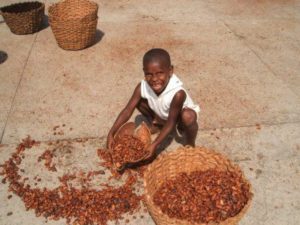How Child Labor Is Used To Make Chocolate Bars
In this BBC Panorama investigation Chocolate: The Bitter Truth reporter Paul Kenyon travelled to West Africa to report on child labour in the cocoa plantations of Ghana and The Ivory Coast.
Cocoa first originated in Central America, and was brought to West Africa a hundred years ago by English colonists. The cocoa tree is not native to West Africa, yet it is now the word’s biggest producer of the cocoa bean in an industry that is worth $80 billion a year globally.
Why Did the Cocoa Tree Travel to Africa
For the cocoa tree to flourish, the climate must have the right humidity, soil and temperature. These climatic conditions are found in a narrow belt of the jungle 10 degrees either side of the equator. That belt passes right through Ghana and The Ivory Coast in West Africa.
Some ten million people depend on the cocoa bean industry in Ghana and The Ivory Coast. The governments of these countries also depend on this trade for tax receipts. Some 60 per cent of the world’s cocoa comes from the two countries.
Child Trafficking in Burkina Faso
Directly to the north of Ghana and the Ivory Coast lies Burkina Faso. This country has also been dragged into the cocoa trade. Children are trafficked, often by a male family member, to work in the cocoa plantations of Ghana and The Ivory Coast.
Child labour is illegal in all three countries, and jails terms can apply if found guilty.
Reporter Paul Kenyon interviews women from Burkina Faso who have not seen their children in up to six years. Kenyon also films and interviews some of the child labourers themselves. None of them go to school, and must do physically demanding work wielding enormous machetes to chop down the cocoa pods, which can grow to the size of a melon.
It’s an extraordinary sight to see these young boys climb trees and perform work that requires the musculature of a grown man.
New York’s Cocoa Bean Traders
Paul Kenyon visits traders in New York who make enormous sums of money from cocoa beans. Nick Gentile, a trader with Atlantic Capital Advisors, says he can make up to $300,000 on a good day trading cocoa beans. He smiles and calls his work as a trader legalised gambling. ‘This is our casino,’ he laughs.
The Harkin-Engel Protocol
To try and compel the industry to be more transparent, American Congressman Eliot L. Engel and Senator Tom Harkin started the Harkin-Engel Protocol in 2001. All the major chocolate companies signed a six point plan to improve the industry. Yet by 2010, nothing substantial had been done to tackle the problem.
Paul Kenyon even establishes that so-called Fair Trade chocolate has child labour cocoa beans seeping into its supply chain. It is obvious that much bigger action needs to be taken to fix the huge problem of child labour being used in the production of chocolate.
One Happy Ending for Quare Fatao Kwakou
Paul Kenyon manages to reunite one of the child labourers, Quare Fatao Kwakou, with his mother. In a moving reunion, the 12 year old says ‘I don’t even find food as sweet as the joy I feel upon seeing my mother.’ Fatao says he wants to study to become a doctor.
The documentary ends with Paul Kenyon asking if we can pay more for chocolate to improve the living standards of those who farm cocoa beans and put a stop, once and for all, to child labour being used on cocoa plantations.





